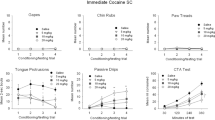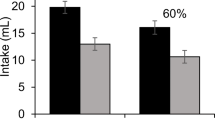Abstract.
Rationale: Conditioned taste aversion (CTA) produced by drugs of abuse such as morphine and cocaine has been interpreted as representing the rewarding actions of these drugs. Evidence for this interpretation is based, in part, on findings in rats indicating saccharin is a more effective conditioning flavor compared to salt (NaCl). However, our studies with ethanol have found salt to be a highly effective conditioning flavor in mice. Objectives: The present series of studies examined the acquisition of CTA to morphine, ethanol, lithium chloride, and cocaine. Further, saccharin and salt were utilized in each experiment in order to determine effectiveness of each flavor to serve as a conditioning stimulus. Methods: In four separate experiments, adult male DBA/2J mice were acclimated to a 2 h/day water restriction regimen. Subsequently they received four conditioning trials consisting of 1 h access to either 0.15% w/v saccharin or 0.1 M salt followed by 0, 10 or 20 mg/kg morphine (experiment 1), 0, 2, or 4 g/kg ethanol (experiment 2), 0, 1.5 or 3.0 milliequivalents/kg lithium chloride (experiment 3) or 0, 10 or 20 mg/kg cocaine (experiment 4). A fifth flavor access period (trial 5) was not followed by drug exposure. Following trial 5, each subject received 24-h access to the conditioning flavor and water (two-bottle test 1). Control subjects (0 dose groups from each experiment) received a second two-bottle test with 24-h access to both saccharin and salt flavors. Results: Reduced flavor intake and reduced flavor preference was noted in all drug-paired groups in each experiment. However, more rapid development of CTA was seen with the saccharin flavor in morphine- or cocaine-paired groups. In contrast, ethanol-induced CTA appeared more rapidly with the salt flavor. Lithium-induced CTA was modest, and emerged equally with either flavor. Conclusions: CTA induced by morphine or cocaine in mice occurs in a similar pattern to that seen in rats, and these findings agree with an interpretation based on drug reward. In contrast, ethanol-induced CTA is more likely attributable to aversive effects.
Similar content being viewed by others
Author information
Authors and Affiliations
Additional information
Electronic Publication
Rights and permissions
About this article
Cite this article
Risinger, F.O., Boyce, J.M. Conditioning tastant and the acquisition of conditioned taste avoidance to drugs of abuse in DBA/2J mice. Psychopharmacology 160, 225–232 (2002). https://doi.org/10.1007/s00213-001-0973-2
Received:
Accepted:
Issue Date:
DOI: https://doi.org/10.1007/s00213-001-0973-2




